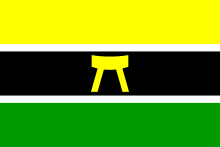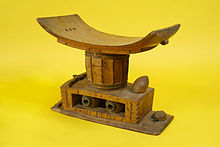Golden Stool


The Golden Stool (Ashanti-Twi: Sika dwa; full title, Sika Dwa Kofi "the Golden Stool born on a Friday") is the royal and divine throne of kings of the Asante people and the ultimate symbol of power in Asante.[1] According to legend, Okomfo Anokye, High Priest and one of the two chief founders of the Asante Confederacy, caused the stool to descend from the sky and land on the lap of the first Asante king, Osei Tutu.[2] Such seats were traditionally symbolic of a chieftain's leadership, but the Golden Stool is believed to house the spirit[3] of the Asante nation—living, dead and yet to be born.
Symbology and ritual
Each stool is understood to be the seat of the owner's soul and when not in use it is placed against a wall so that other souls passing by may relax on it. The Golden Stool is the royal throne and must never touch the ground; instead it is placed on a blanket.[4] During inauguration, a new king is raised and lowered over the stool without touching it.[5] The Golden Stool is carried to the king on a pillow,[6] as only the Asantehene himself is allowed to handle it. During solemn occasions, the Golden Stool is placed on the king's left on a throne of its own, the hwedom dwa (Asante, throne facing the crowd).[7]
Historical conflict
Many wars[8] have broken out over the ownership of the royal throne.[9] In 1896, Asantehene Prempeh I was deported rather than risk losing both the war and the throne. In 1900, Sir Frederick Hodgson, the Governor of the Gold Coast, demanded[5] to be allowed to sit on the Golden Stool, and ordered that a search for it be conducted. This provoked an armed rebellion known as the War of the Golden Stool, which resulted in the annexation of Ashanti to the British Empire, but preserved the sanctity of the Golden Stool. In 1921, African road workers discovered the stool and stripped some of the gold ornaments.[10] They were taken into protective custody by the British, before being tried according to local custom and sentenced to death.[10] The British intervened and the group was instead banished.[10] An assurance of non-interference with the stool was then given by the British and it was brought out of hiding.[10]
In 1935 the stool was used in the ceremony to crown Osei Tutu Agyeman Prempeh II.[11]
Appearance and craftsmanship

The Golden Stool is a curved seat 46 cm high with a platform 61 cm wide and 30 cm deep.[12] Its entire surface is inlaid with gold, and hung with bells to warn the king of impending danger.[13][self-published source?] It has not been seen by many and only the king, queen, and trusted advisers know the hiding place. Replicas have been produced for the chiefs and at their funerals are ceremonially blackened with animal blood, a symbol of their power for generations.[14][self-published source?] The stool is one of the main focal points of the Asante today because it still shows succession and power.[9]
While the Golden Stool is made of pure gold, stools are often made from wood. Each stool is made from a single block of the wood of Alstonia boonei (a tall forest tree with numinous associations) and carved with a crescent-shaped seat, flat base and complex support structure. The many designs and symbolic meanings mean that every stool is unique; each has a different meaning for the person whose soul it seats.[15] Some designs contain animal shapes or images that recall the person who used it. The general shape of Asante stools has been copied by other cultures and sold worldwide.[16][citation needed]
References
- ^ "African Gold-weights in the British Museum".
- ^ "How the Asantehene climaxed the 20th anniversary on the Golden Stool [PHOTOS]". www.graphic.com.gh. 2019-04-22. Retrieved 2019-05-18.
- ^ Kyerematen, A. (1969). "The Royal Stools of Ashanti". Africa: Journal of the International African Institute. 39 (1): 1–10. doi:10.2307/1157946. ISSN 0001-9720. JSTOR 1157946. S2CID 144362829.
- ^ "What is the royal and sacred object of the Ashanti people?". GlobalQuiz. Retrieved 2020-02-22.
- ^ a b "History of Golden Stool". www.ghanaweb.com. Retrieved 2020-02-22.
- ^ "Queen-Mother Yaa Asantewaa and the Golden Stool. | Hadithi Africa". Archived from the original on 2020-02-22. Retrieved 2020-02-22.
- ^ "Akan Leadership Arts".
- ^ "Golden Stool of the Asante". History of International Relations. 2018-10-14. Archived from the original on 2019-10-28. Retrieved 2020-02-22.
- ^ a b "Asante Art - Artefacts - Stools". asante.neocities.org. Retrieved 2020-02-22.
- ^ a b c d Carmichael, John (1993). African Eldorado - Gold Coast to Ghana. Gerald Duckworth & Co. Ltd. pp. 176–77. ISBN 0-7156-2387-7.
- ^ Michael T. Kaufman (March 4, 1999). "Opoku Ware II, King of Asante, Is Dead at 89". New York Times.
- ^ "How a mysterious Golden Stool is keeping the great Ashanti kingdom united". Face2Face Africa. 2018-09-20. Retrieved 2020-02-22.
- ^ Yussif, Elias (2013-07-24). The Facet of Black Culture. Trafford Publishing. ISBN 978-1-4669-8848-4.
- ^ Hadzija, Boka (November 2013). My Door is Always Open: A Memoir. Xlibris Corporation. ISBN 978-1-4836-2925-4.
- ^ "Asante (Ashanti) Abstract Stools 2". www.hamillgallery.com. Retrieved 2020-02-22.
- ^ "Asante Kotoro Dwa Stool". Exquisite African Art. Retrieved 2020-02-22.
